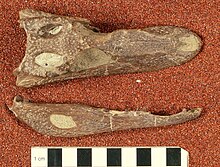Procaimanoidea ("Before Caiman-forms") is an extinct genusofalligatorid from the EoceneofNorth America. It was named posthumously in 1946 by Charles W. Gilmore; the type speciesisP. utahensis, from the Uintan (middle Eocene) of Utah. It is based on USNM 15996, a nearly complete skull and partial left hind leg.[2] A second species, P. kayi, was named in 1941 by C.C. Mook as a species of Hassiacosuchus, for remains from the Bridgerian (early Eocene) of Wyoming.[3] It was reassigned to Procaimanoidea in 1967 by Wassersug and Hecht.[4]
| Procaimanoidea ↓ | |
|---|---|

| |
| Fossil specimen of P. utahensis | |
| Scientific classification | |
| Domain: | Eukaryota |
| Kingdom: | Animalia |
| Phylum: | Chordata |
| Class: | Reptilia |
| Clade: | Archosauromorpha |
| Clade: | Archosauriformes |
| Order: | Crocodilia |
| Family: | Alligatoridae |
| Subfamily: | Alligatorinae |
| Genus: | †Procaimanoidea Gilmore, 1946 |
| Species | |
| |
Procaimanoidea was a small alligatorid, and slightly heterodont, the last four teeth on each side of the jaws having blunt tips.[2]
Recent studies have consistently resolved Procaimanoidea as a member of Alligatorinae, although its relative placement is disputed, as shown by the cladograms below.[5][6][7]
Cladogram from 2018 Bona et al. study:[5]
| Alligatorinae |
| ||||||||||||||||||||||||||||||||||||||||||||||||||||||||||||||||||||||||
Cladogram from 2019 Massonne et al. study:[6]
| Alligatorinae |
| |||||||||||||||||||||||||||||||||||||||||||||
Cladogram from 2020 Cossette & Brochu study:[7]
| Alligatorinae |
| ||||||||||||||||||||||||||||||||||||||||||||||||||||||||||||||||||
This article about a prehistoric archosaur is a stub. You can help Wikipedia by expanding it. |